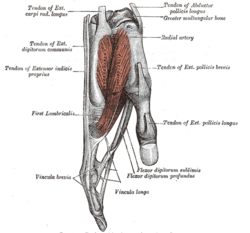Lumbricals of the hand
The lumbricals are intrinsic muscles of the hand that flex the metacarpophalangeal joints and extend the interphalangeal joints.[1]
Structure
There are four of these small, worm-like muscles on each hand. These muscles are unusual in that they do not attach to bone. Instead, they attach proximally to the tendons of flexor digitorum profundus and distally to the extensor expansions.[1]
| # | Form | Origin | Insertion |
| first | unipennate | It originates from the radial side of the most radial tendon of the flexor digitorum profundus (corresponding to the index finger). | It passes posteriorly along the radial side of the index finger to insert on the extensor expansion near the metacarpophalangeal joint. |
| second | unipennate | It originates from the radial side of the second most radial tendon of the flexor digitorum profundus (which corresponds to the middle finger). | It passes posteriorly along the radial side of the middle finger and inserts on the extensor expansion near the metacarpophalangeal joint. |
| third | bipennate | One head originates on the radial side of the flexor digitorum profundus tendon corresponding to the ring finger, while the other originates on the ulnar side of the tendon for the middle finger. | The muscle passes posteriorly along the radial side of the ring finger to insert on its extensor expansion. |
| fourth | bipennate | One head originates on the radial side of the flexor digitorum profundus tendon corresponding to the little finger, while the other originates on the ulnar side of the tendon for the ring finger. | The muscle passes posteriorly along the radial side of the little finger to insert on its extensor expansion. |
Innervation
The first and second lumbricals (the most radial two) are innervated by the median nerve.
The third and fourth lumbricals (most ulnar two) are innervated by the deep branch of the ulnar nerve.
This is the usual innervation of the lumbricals (occurring in 60% of individuals). However 1:3 (median:ulnar - 20% of individuals) and 3:1 (median:ulnar - 20% of individuals) also exist. The lumbrical innervation always follows the innervation pattern of the associated muscle unit of flexor digitorum profundus (i.e. if the muscle units supplying the tendon to the middle finger are innervated by the median nerve, the second lumbrical will also be innervated by the median nerve).[2]
Blood supply
There are four separate sources of blood supply for these muscles: the superficial palmar arch, the common palmar digital artery, the deep palmar arch, and the dorsal digital artery.
Actions
The lumbrical muscles, with the help of the interosseous muscles, simultaneously flex the metacarpophalangeal joints while extending both interphalangeal joints of the digit on which it inserts. The lumbricals are used during an upstroke in writing.
Other lumbricals
There are also lumbrical muscles of the foot that have a similar action, though these are of less clinical concern.
Additional images
| Tendons of forefinger and vincula tendina |
| Muscles of hand. Cross section. |
| Wrist joint. Deep dissection.Anterior, palmar, view. |
| Wrist joint. Deep dissection.Anterior, palmar, view. |
| Wrist joint. Deep dissection.Anterior, palmar, view. |
|
Notes
References
- Gosling, J.A.; Harris, P.F.; Humpherson, J.R.; Whitmore, I.; Willan, P.L.T. (2008). Human Anatomy: Color Atlas and Textbook. phot. by A.L. Bentley (5th ed.). Philadelphia: Mosby. ISBN 978-0-7234-3451-1.
|
|---|
| | Shoulder | |
|---|
| Arm
(compartments) | |
|---|
| | Forearm | |
|---|
| | Hand | | lateral volar | |
|---|
| | medial volar | |
|---|
| | intermediate | |
|---|
| | fascia | |
|---|
|
|---|
| |
|---|
| | Description |
- Anatomy
- head
- neck
- arms
- chest and back
- diaphragm
- abdomen
- genital area
- legs
- Muscle tissue
- Physiology
|
|---|
| | Disease |
- Myopathy
- Soft tissue
- Connective tissue
- Congenital
- abdomen
- muscular dystrophy
- Neoplasms and cancer
- Injury
- Symptoms and signs
|
|---|
| | Treatment |
- Procedures
- Drugs
- anti-inflammatory
- muscle relaxants
|
|---|
|
|
.png)
